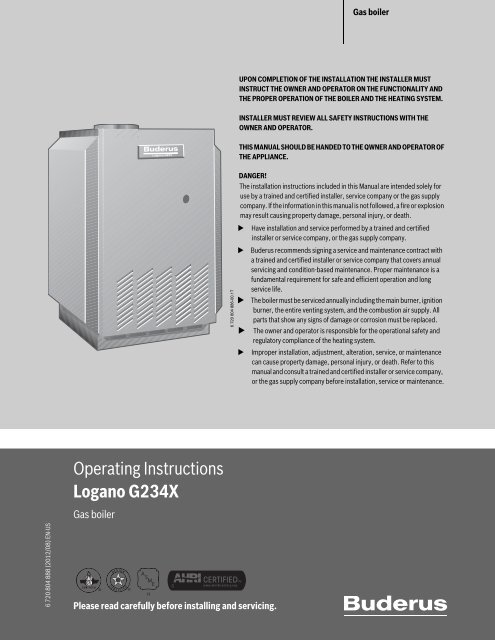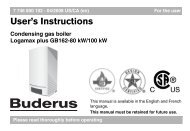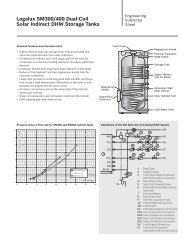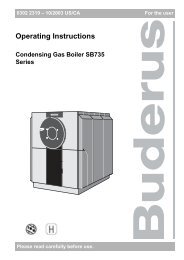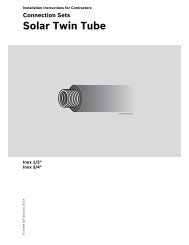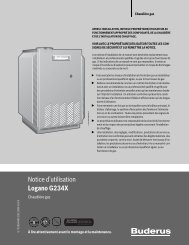Download - Buderus
Download - Buderus
Download - Buderus
Create successful ePaper yourself
Turn your PDF publications into a flip-book with our unique Google optimized e-Paper software.
Gas boiler<br />
UPON COMPLETION OF THE INSTALLATION THE INSTALLER MUST<br />
INSTRUCT THE OWNER AND OPERATOR ON THE FUNCTIONALITY AND<br />
THE PROPER OPERATION OF THE BOILER AND THE HEATING SYSTEM.<br />
INSTALLER MUST REVIEW ALL SAFETY INSTRUCTIONS WITH THE<br />
OWNER AND OPERATOR.<br />
THIS MANUAL SHOULD BE HANDED TO THE QWNER AND OPERATOR OF<br />
THE APPLIANCE.<br />
6 720 804 886-00.1T<br />
DANGER!<br />
The installation instructions included in this Manual are intended solely for<br />
use by a trained and certified installer, service company or the gas supply<br />
company. If the information in this manual is not followed, a fire or explosion<br />
may result causing property damage, personal injury, or death.<br />
Have installation and service performed by a trained and certified<br />
installer or service company, or the gas supply company.<br />
<strong>Buderus</strong> recommends signing a service and maintenance contract with<br />
a trained and certified installer or service company that covers annual<br />
servicing and condition-based maintenance. Proper maintenance is a<br />
fundamental requirement for safe and efficient operation and long<br />
service life.<br />
The boiler must be serviced annually including the main burner, ignition<br />
burner, the entire venting system, and the combustion air supply. All<br />
parts that show any signs of damage or corrosion must be replaced.<br />
The owner and operator is responsible for the operational safety and<br />
regulatory compliance of the heating system.<br />
Improper installation, adjustment, alteration, service, or maintenance<br />
can cause property damage, personal injury, or death. Refer to this<br />
manual and consult a trained and certified installer or service company,<br />
or the gas supply company before installation, service or maintenance.<br />
Operating Instructions<br />
Logano G234X<br />
Gas boiler<br />
6 720 804 888 (2012/08) EN-US<br />
Please read carefully before installing and servicing.
Contents<br />
Contents<br />
1 Safety considerations . . . . . . . . . . . . . . . . . . . . . . . . . . . . . . . . . 2<br />
1.1 Key to symbols . . . . . . . . . . . . . . . . . . . . . . . . . . . . . . . . . 2<br />
1.2 Safety instructions . . . . . . . . . . . . . . . . . . . . . . . . . . . . . . 2<br />
2 Product information . . . . . . . . . . . . . . . . . . . . . . . . . . . . . . . . . . . 4<br />
2.1 Correct use . . . . . . . . . . . . . . . . . . . . . . . . . . . . . . . . . . . . 4<br />
2.2 Certification and testing mark . . . . . . . . . . . . . . . . . . . . . 4<br />
2.3 Disposal . . . . . . . . . . . . . . . . . . . . . . . . . . . . . . . . . . . . . . 4<br />
2.4 Product description . . . . . . . . . . . . . . . . . . . . . . . . . . . . . 4<br />
3 Operation . . . . . . . . . . . . . . . . . . . . . . . . . . . . . . . . . . . . . . . . . . . . 4<br />
3.1 Before operating the appliance . . . . . . . . . . . . . . . . . . . . 4<br />
3.2 Checking the operating pressure, topping up<br />
the boiler water, and purging air from the system . . . . . 4<br />
3.2.1 Checking the operating pressure . . . . . . . . . . . . . . . . . . 4<br />
3.2.2 Topping up the heating water and bleeding the system . 5<br />
3.3 Start up instructions . . . . . . . . . . . . . . . . . . . . . . . . . . . . . 5<br />
3.4 Shut down the heating system . . . . . . . . . . . . . . . . . . . . 7<br />
3.4.1 Normal system shut-down . . . . . . . . . . . . . . . . . . . . . . . . 7<br />
3.4.2 Emergency shut-down procedures . . . . . . . . . . . . . . . . . 7<br />
3.5 Operating Tips . . . . . . . . . . . . . . . . . . . . . . . . . . . . . . . . . 7<br />
3.6 Why is annual maintenance important . . . . . . . . . . . . . 7<br />
1 Safety considerations<br />
1.1 Key to symbols<br />
Warnings<br />
The following keywords are defined and can be used in this document:<br />
• NOTICE indicates that property damage may occur.<br />
• CAUTION indicates that personal injury may occur.<br />
• WARNING indicates that severe personal injury may occur.<br />
• DANGER indicates that severe personal injury or death may occur.<br />
Important Information<br />
Additional symbols<br />
Symbol<br />
▶<br />
<br />
Warnings in this document are identified by a warning<br />
triangle printed against a grey background. Keywords at<br />
the start of a warning indicate the type and seriousness<br />
of the ensuing risk if measures to prevent the risk are not<br />
taken.<br />
Important information for the proper use of the boiler is<br />
also provided in this manual. You will find the information<br />
with a symbol shown on the left and bordered by<br />
horizontal lines above and below the text.<br />
Explanation<br />
Sequence of steps<br />
Cross-reference to other points in this document or to<br />
other documents<br />
• Listing/list entry<br />
– Listing/list entry (2nd level)<br />
Table 1<br />
1.2 Safety instructions<br />
If you hear gas leaking<br />
▶ Leave the building immediately.<br />
▶ Prevent others from entering the building.<br />
▶ Notify the police and fire department from outside the building.<br />
▶ From outside the building, call the gas supply company and a trained<br />
and certified installer or service company.<br />
If you smell gas<br />
▶ Turn off the gas shut-off valve.<br />
▶ Open windows and doors.<br />
▶ Do not touch any electrical switch, telephone, and do not use outlets.<br />
▶ Extinguish all open flames.<br />
▶Do not smoke.<br />
▶ Do not use lighters.<br />
▶ Warn all occupants of the building that they need to leave the building.<br />
▶ Do not ring doorbells.<br />
▶ Notify the police and fire department from outside the building.<br />
▶ From outside the building, call the gas supply company and a trained<br />
and certified installer or service company.<br />
2<br />
Logano G234X – 6 720 804 888 (2012/08)
Safety considerations<br />
1<br />
If you smell flue gas<br />
▶ Switch off the heating system by shutting off the emergency shut-off<br />
switch.<br />
▶ Open windows and doors.<br />
▶ Call a trained and certified installer or service company<br />
DANGER: Risk of fatal injury from failing to consider your own<br />
safety<br />
▶ Never risk your own life. Your own safety must always take the highest<br />
priority.<br />
DANGER: Risk of fire when soldering and brazing<br />
▶ Take appropriate protective measures when soldering and brazing<br />
around combustible and flammable material.<br />
DANGER: Risk of personal injury or death from flue gas poisoning<br />
▶ Do not install a thermostatic flue gas damper downstream of the draft<br />
hood.<br />
▶ Do not tamper with, remove, or attempt to repair the blocked vent<br />
switch.<br />
▶ When replacing the blocked vent switch, install the new part in the<br />
original location.<br />
▶ A blocked vent switch tripping more than once indicates a problem<br />
with the venting system or chimney which must be repaired<br />
immediately.<br />
▶ Ensure none of the vent pipes and chimneys are damaged or blocked.<br />
▶ Connect only one appliance to each venting system or chimney.<br />
▶ The venting system must not feed into or route through another air<br />
extraction duct.<br />
▶ The venting system must be inspected annually. All parts that show<br />
any signs of damage or corrosion must be replaced.<br />
DANGER: Risk of personal injury or death from explosion<br />
▶ Work on gas components may only be carried out by a trained and<br />
certified installer or service company.<br />
▶ Appliance installation, the connection of gas and vent piping, initial<br />
commissioning, electrical connections, and service and maintenance<br />
must only be carried out by a trained and certified installer or service<br />
company.<br />
DANGER: Risk of personal injury or death from flue gas poisoning<br />
▶ Never close off or reduce the size of the combustion air openings.<br />
▶ The boiler must not be operated until any obstructions have been<br />
removed.<br />
DANGER: Risk of personal injury or death from fire<br />
▶ Do nut use flammable or combustible material in the boiler room.<br />
▶ It is recommended not to store any items within 16 inches (415 mm)<br />
of the appliance.<br />
DANGER: Risk of personal injury or death from electric shock<br />
▶ Before removing the front panel, disconnect the heating system from<br />
the electrical power supply by shutting off the emergency shutoff<br />
switch or the heating system circuit breaker.<br />
▶ It is not enough to switch off the control panel. Power to the panel<br />
must be disconnected.<br />
▶ Ensure that the power is not restored unintentionally by following<br />
proper lock out/tag out procedures.<br />
▶ Only qualified electricians are permitted to carry out electrical work.<br />
DANGER: Safety devices<br />
▶ Never shut off safety valves.<br />
▶ Hot water may escape from the safety valve at any time when the<br />
appliance is running.<br />
DANGER: Risk of personal injury or death after a flood<br />
▶ Do not attempt to operate an appliance if any part of it has been under<br />
water.<br />
▶ An appliance that was subject to flooding must be replaced.<br />
CAUTION: Appliance damage from contaminated combustion air<br />
▶ Keep the combustion air free of corrosive substances, e.g.<br />
halogenated hydrocarbons from painting operations or beauty<br />
salons.<br />
▶ Keep combustion air free from dust and lint, e.g. from laundry or<br />
agricultural operations.<br />
▶ If clean room air is not available, fresh outdoor combustion air must be<br />
provided.<br />
NOTICE: Risk of appliance damage from improper operation of the<br />
boiler<br />
▶ Only use the boiler for its intended purpose.<br />
▶ Only operate the boiler if it has been installed and maintained per the<br />
instructions provided in the Installation Manual.<br />
▶ Do not attempt to operate an appliance if any part of it is not in<br />
working order or is damaged.<br />
▶ Use only original spare parts. The use of parts not supplied by the<br />
manufacturer may cause damage to the boiler, other property and<br />
personal injury. Also, boiler damage caused by the use of<br />
unauthorized parts is not covered by the warranty.<br />
NOTICE:<br />
▶ The installation must comply with all applicable national, state, and<br />
local codes, rules, and regulations.<br />
▶ The operator is responsible for the operational safety and regulatory<br />
compliance of the heating system.<br />
▶ In the Commonwealth of Massachusetts, the appliance must be<br />
installed by a licensed plumber or gas fitter.<br />
NOTICE:<br />
▶ Upon completion of the installation, these instructions should be<br />
handed to the owner and operator of the appliance.<br />
▶ The installer must instruct the owner and operator on the functionality<br />
of the components and the proper operation of the boiler and the<br />
heating system.<br />
▶ The boiler must be serviced annually including the main burner,<br />
ignition burner, the entire venting system, and the combustion air<br />
supply. All parts that show any signs of damage or corrosion must be<br />
replaced.<br />
Logano G234X – 6 720 804 888 (2012/08) 3
2 Product information<br />
2 Product information<br />
To ensure safe, economical and environmentally friendly use of the<br />
heating system, we recommend that you carefully read the safety<br />
instructions and operating instructions.<br />
These instructions provide the operator of the heating system with an<br />
overview of the use and operation of the boiler.<br />
2.1 Correct use<br />
The boiler is designed for heating central heating system water and<br />
indirect provision of domestic hot water (e.g. via a hot water storage<br />
tank) in residential buildings or apartment buildings. Any other purpose<br />
is considered improper use.<br />
2.2 Certification and testing mark<br />
This appliance has been tested and meets the basic standards for the US<br />
and Canadian markets.<br />
2.3 Disposal<br />
▶ Dispose of boiler packaging in an environmentally-responsible<br />
manner.<br />
▶ All heating system components that have to be replaced should be<br />
disposed of in environmentally-responsible manner at an authorized<br />
disposal site.<br />
Fig. 1 G234X boiler<br />
[1] AquaSmart TM<br />
[2] Burner control unit<br />
[3] Boiler block with thermal insulation<br />
[4] Boiler casing<br />
[5] Burner<br />
[6] Front panel of boiler<br />
6 720 804 886-01.1T<br />
2.4 Product description<br />
The boiler is fully functional with the factory-installed<br />
AquaSmart TM .<br />
The G234X model boiler is a low temperature atmospheric gas-fired<br />
boiler.<br />
The boiler consists of:<br />
• Ignition module and boiler temperature controller<br />
• Boiler jacket and front door<br />
• Boiler block with insulation<br />
• Gas burner<br />
The ignition module and boiler temperature controller monitor and<br />
control all electrical components of the boiler.<br />
The boiler jacket prevents energy loss and acts as soundproofing.<br />
The boiler block transfers the heat generated by the burner to the boiler<br />
water. The insulation prevents energy loss.<br />
3 Operation<br />
If you are not comfortable performing the following<br />
operations contact you trained and certified installer.<br />
3.1 Before operating the appliance<br />
Before starting up the appliance, make sure that<br />
• the operating pressure is sufficient<br />
• the fuel supply has been turned on at the main shut-off valve, and<br />
• the heating system emergency shutoff switch is in the ON position.<br />
3.2 Checking the operating pressure, topping up<br />
the boiler water, and purging air from the system<br />
The water used for filling the heating system loses a substantial amount<br />
of volume in the first few days due to the release of its gas content. This<br />
causes air pockets to form and the heating water starts to make noises.<br />
▶ With new heating systems, check the operating pressure daily at first,<br />
topping off the heating water and bleeding the radiators if needed.<br />
▶ Later on, check the operating pressure monthly, topping off heating<br />
water and purging the boiler and radiators if needed.<br />
3.2.1 Checking the operating pressure<br />
Your heating contractor will have set the system to the required<br />
operating pressure of at least 15 psi (1 bar) and entered the setting in<br />
Tab. 2, page 5.<br />
▶ Read the current operating pressure and temperature from the<br />
temperature/pressure gauge.<br />
▶ If the temperature/pressure gauge needle drops below the minimum<br />
pressure marker of 15 psi (1 bar), the operating pressure is too low.<br />
Add water to the system.<br />
4<br />
Logano G234X – 6 720 804 888 (2012/08)
Operation<br />
3<br />
3.3 Start up instructions<br />
For your safety, read before start up.<br />
DANGER: Risk of fatal injury due to not observing the<br />
start-up instructions and resulting incorrect operation!<br />
▶ If these instructions are not followed, a fire or<br />
explosion may result.<br />
Fig. 2<br />
Pressure/temperature gauge<br />
3.2.2 Topping up the heating water and bleeding the system<br />
Ask your heating contractor to show you where the boiler fill & drain<br />
valve for topping off the heating system is located.<br />
WARNING: Health risk from contaminated drinking<br />
water!<br />
▶ It is imperative that you observe all regulations and<br />
standards applicable in your country regarding<br />
prevention of drinking water contamination.<br />
CAUTION: Risk of damage to system due to temperature<br />
stress!<br />
If you fill the heating system when it is hot, the resulting<br />
temperature stress can cause stress cracks. The boiler<br />
will then leak.<br />
▶ Only top off the heating system when it is below a<br />
supply temperature of 100 °F (38 °C).<br />
▶ Slowly fill the heating system. Observe the temperature/pressure<br />
gauge while filling.<br />
CAUTION: Risk of system damage due to frequent<br />
topping off!<br />
If you have to top off the boiler water once a month, the<br />
heating system may suffer damage from corrosion or<br />
scale buildup, depending on the water quality.<br />
▶ Ask your trained and certified installer if the local<br />
water can be used untreated or whether it needs to be<br />
treated.<br />
▶ Notify your heating contractor if you find you need to<br />
top off your heating system once a month.<br />
Operating pressure<br />
Design operating pressure<br />
(optimum setting)<br />
_____________ psi<br />
Maximum heating system operating<br />
pressure<br />
(standard = 30 psi/2bar)<br />
_____________ psi<br />
Table 2 Operating pressure (entered by system installer)<br />
7 747 010 720-24.2RS<br />
DANGER: Risk of explosion!<br />
If you smell gas there is a danger of explosio n.<br />
▶ Close the gas shut-off valve.<br />
▶ Open windows and doors.<br />
▶ Do not operate any electrical switches or equipment<br />
such as telephones, power plugs and doorbells.<br />
▶ Extinguish all open flames. Do not smoke. Do not use<br />
lighters.<br />
▶ Warn all occupants of the building, but do not ring<br />
doorbells.<br />
▶ If you can actually hear gas escaping, leave the<br />
building immediately. Prevent others from entering<br />
and notify the police and fire department from<br />
outside the building.<br />
▶ From outside the building, call the gas utility<br />
company and approved heating contractor.<br />
WARNING: Risk of system damage!<br />
This unit is fitted with an ignition module that<br />
automatically starts the pilot burner.<br />
▶ Do not attempt to ignite it manually.<br />
WARNING: Risk of system damage!<br />
This test must also be conducted at floor level, because<br />
some types of gas are heavier than air and may<br />
accumulate at floor level.<br />
▶ Check for an odor of gas around the heating system.<br />
WARNING: Risk of system damage!<br />
Any attempt to use force or to repair the valve may cause<br />
a fire or explosion.<br />
▶ Switch on the ON/OFF switch on the gas valve by<br />
hand only.<br />
▶ Never use a tool as assistance.<br />
▶ If you cannot actuate the ON/OFF switch on the gas<br />
valve by hand, do not attempt to repair it.<br />
▶ Contact a trained and certified installer.<br />
WARNING: Risk of system damage!<br />
▶ Do not operate the appliance if any part is under<br />
water.<br />
▶ Contact a trained and certified installer immediately.<br />
Logano G234X – 6 720 804 888 (2012/08) 5
3 Operation<br />
WARNING: Risk of fatal injury due to not observing the<br />
start-up instructions and resulting incorrect operation!<br />
▶ If these instructions are not followed, a fire or<br />
explosion may result.<br />
▶ Switch on electric power to heating system.<br />
STOP! First read the safety instructions on page 5 of these instructions.<br />
▶ Set thermostat to the lowest value.<br />
▶ Shut off the heating system from the power supply.<br />
▶ Close main gas shut-off.<br />
▶ Unscrew left and right screws [1] in the side panels, lift front panel of<br />
boiler [3] up, pull outward and remove to the front.<br />
Fig. 3 Remove front panel of boiler<br />
[1] Locking screws<br />
[2] Boiler jacket<br />
[3] Front panel of boiler<br />
▶ Turn the gas valve ON/OFF dial [1] clockwise to the OFF position. Do<br />
not use force.<br />
▶ Wait five (5) minutes until all gas residues have dissipated. Finally<br />
check whether there is any smell of gas, including at floor level. If you<br />
smell gas, STOP! Follow instructions in section “B” of the safety<br />
instructions ( page 5).<br />
If you do not smell gas, go to the next step.<br />
Fig. 4 Gas valve<br />
[1] ON/OFF dial (at OFF position)<br />
▶ Set thermostat to desired room temperature.<br />
▶ If the heating system does not start up, follow the instructions above<br />
for turning off the gas supply. After that, inform a customer service<br />
technician or the gas utility company.<br />
Flame roll-out switch<br />
The boiler is equipped with a flame roll-out switch. If the flue duct in the<br />
boiler is blocked, the flame roll-out switch responds.<br />
Do not try to light the boiler in this case. Inform a qualified service<br />
company. The flue duct in the boiler must be checked for blockage and<br />
the flame baffle replaced.<br />
The flame roll-out switch is for one-time use only. Do not try to use it<br />
again.<br />
Flue gas monitoring switch<br />
The boiler is equipped with a flue gas monitor. If the flue gas escape of<br />
the boiler is blocked the flue gas monitoring switch reacts. The flue gas<br />
monitoring switch is mounted directly on the draft hood.<br />
This unit is fitted with an ignition module that<br />
automatically starts the pilot burner. Do not attempt to<br />
ignite it manually.<br />
▶ Turn gas valve ON/OFF dial[1] counterclockwise to ON position. Do<br />
not use force.<br />
▶ Replace front panel of boiler ( Fig. 3).<br />
▶ Open main gas shut-off.<br />
Fig. 5 Gas valve<br />
[1] ON/OFF button (at OFF position)<br />
Do not try to light the boiler if the flue gas escape of the boiler is blocked.<br />
Inform a qualified service company. The flue gas path must be searched<br />
for blockages. In order to start the boiler up again, the flue gas<br />
monitoring switch must first be reset.<br />
6<br />
Logano G234X – 6 720 804 888 (2012/08)
Operation<br />
3<br />
3.4 Shut down the heating system<br />
CAUTION: Risk of system damage due to freezing!<br />
If the heating system has been switched off, it may<br />
freeze in cold weather conditions.<br />
▶ Protect your system from freezing by draining the<br />
boiler, the heating system and hot water pipes at the<br />
lowest point.<br />
3.4.1 Normal system shut-down<br />
▶ Switch off the on/off switch ("OFF" position). This switches off the<br />
boiler and all its components (e.g. burner).<br />
▶ Further shut-down procedure refer to AquaSmart TM documentation.<br />
▶ Shut off fuel supply by closing main valve.<br />
Notes about the boiler room<br />
Only use this fuel type<br />
____________________________<br />
____________________________________________ Stamp/Date/Signature<br />
Table 3 Fuel to be used (entered by heating system installer)<br />
CAUTION: Risk of boiler damage from contaminated<br />
combustion air!<br />
▶ Keep the combustion air free of corrosive substances<br />
(e. g. halogenated hydrocarbons that contain<br />
chlorine or fluorine compounds). This will help<br />
prevent corrosion.<br />
▶ Prevent heavy accumulation of dust.<br />
CAUTION: Risk of system damage from water!<br />
▶ In the event of severe risk of flooding, disconnect the<br />
boiler from its power supply and shut off the fuel<br />
supply before water enters the boiler room.<br />
▶ All parts that have been in contact with water must be<br />
replaced by a trained and certified installer.<br />
Fig. 6 Heating system shut-down<br />
[1] ON/OFF switch (emergency shut off switch)<br />
3.4.2 Emergency shut-down procedures<br />
Use the heating system emergency shut-off switch<br />
located outside the boiler room or the heating system<br />
circuit breaker for emergency shutdown.<br />
Action in an emergency<br />
▶ Never risk your own life. Your own safety must always take the highest<br />
priority.<br />
▶ Shut off fuel supply by closing main valve.<br />
▶ Disconnect the heating system from the electrical power supply by<br />
means of the emergency shutoff switch or the appropriate circuit<br />
breaker.<br />
3.6 Why is annual maintenance important<br />
Heating systems should be maintained annually for the following<br />
reasons:<br />
• to maintain high efficiency,<br />
• to operate the system economically (low fuel consumption),<br />
• to maintain the cleanest combustion.<br />
CAUTION: Risk of damage to system due to lack of or<br />
inadequate cleaning and maintenance!<br />
▶ Have your heating system inspected, cleaned and<br />
maintained by a trained and certified installer once a<br />
year.<br />
▶ We recommend you sign a contract covering an<br />
annual inspection and maintenance.<br />
3.5 Operating Tips<br />
The right fuel<br />
To ensure it operates properly, the heating system requires fuel of the<br />
correct type and grade.<br />
CAUTION: Risk of system damage from use of incorrect<br />
fuel!<br />
▶ Only use the fuel specified. The correct fuel is entered<br />
in Tab. 3 by the heating system installer.<br />
Consult your trained and certified installer if you want to convert your<br />
heating system to a different fuel or run the boiler on fuel with different<br />
specifications.<br />
Logano G234X – 6 720 804 888 (2012/08) 7
United States and Canada<br />
Bosch Thermotechnology Corp.<br />
50 Wentworth Avenue<br />
Londonderry, NH 03053<br />
Tel. 603-552-1100<br />
Fax 603-584-1681<br />
www.buderus.us<br />
U.S.A.<br />
Products manufactured by<br />
Bosch Thermotechnik GmbH<br />
Sophienstrasse 30-32<br />
D-35576 Wetzlar<br />
www.buderus.com<br />
Bosch Thermotechnology Corp. reserves the right<br />
to make changes without notice due to continuing<br />
engineering and technological advances.


